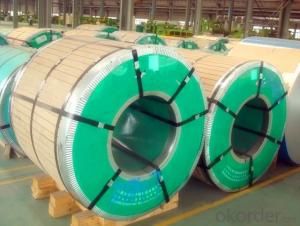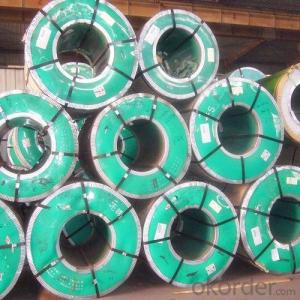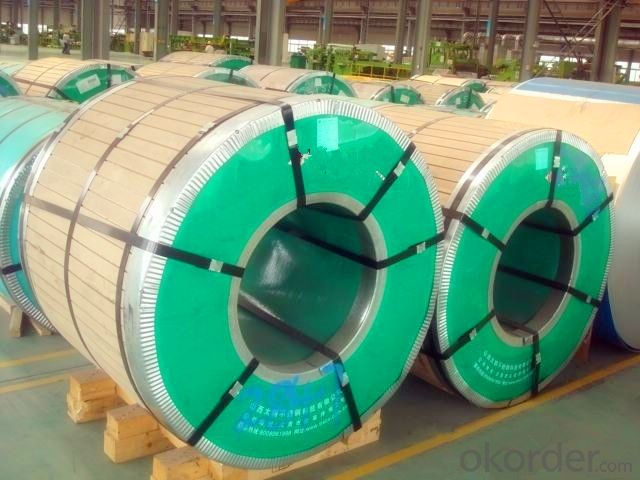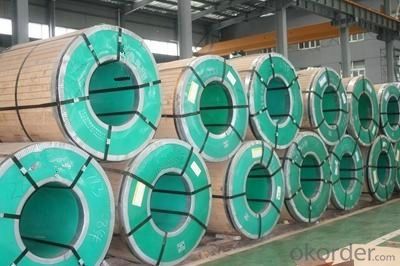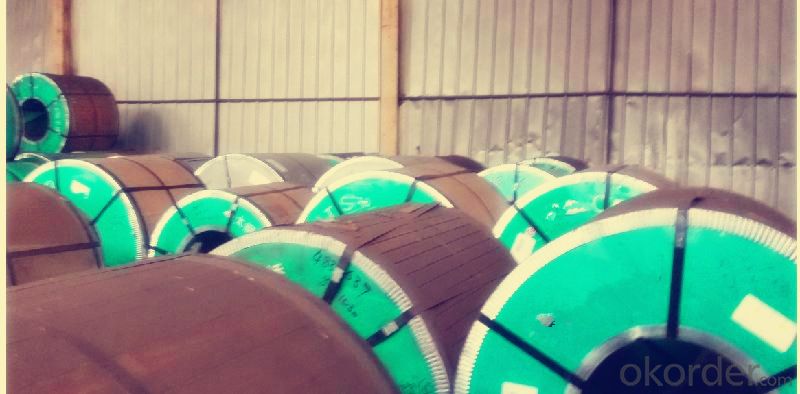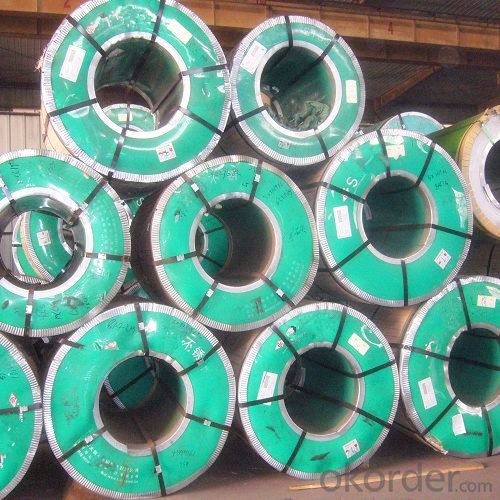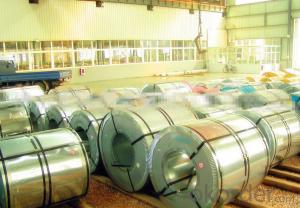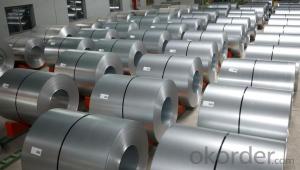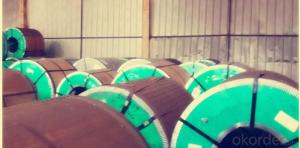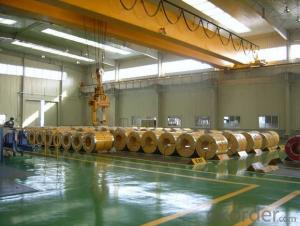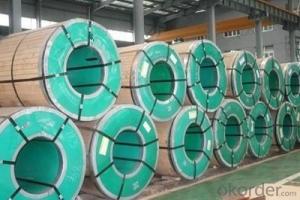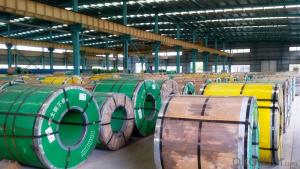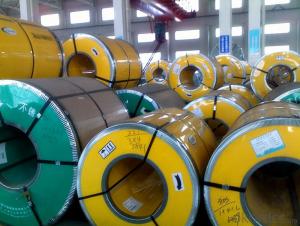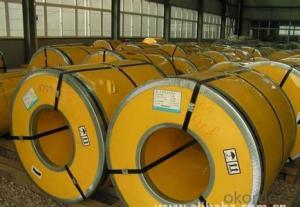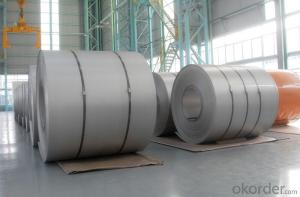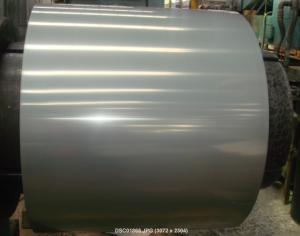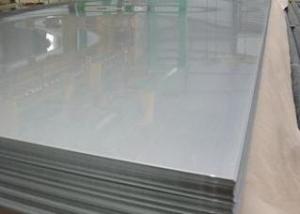Hot Rolled Stainless Steel Coil 304 No.1 Narrow
OKorder Service Pledge
OKorder Financial Service
You Might Also Like
Hot Rolled Stainless Steel Coil 304 Annealing and Pickling No.1 Finish
Stainless steel is a production which not easy rust,acid resistance and corrosion resistance,so it is widely
used in light industry,heavy industry,daily necessities and the decoration industry.
Hot Rolled Stainless Steel Coil 304 Specifications
1.surface:NO.1
2.standard:JIS, AISI, GB
3.width: 0.55m, 0.65m, 1.0m, 1.22m, 1.5m, 2m or requirement
Hot Rolled Stainless Steel Coil 304 Chemical Composition:
(%):C=0.07, Mn=2.00, P=0.045, S=0.030, Si=0.075, Cr=17.5-19.5, Ni=8.0-10.5, N=0.10
Hot Rolled Stainless Steel Coil 304 Physical Properties
Tensile strength σb (MPa) ≥ 520
the conditions yield strength σ0.2 (MPa) ≥ 205,
elongation δ5 (%) ≥ 40
Reduction of ψ (%) ≥ 50,
hardness: ≤ 187
HB; ≤ 90
HRB; ≤ 200H
Type | Hot Rolled Stainless Steel Coil 304 |
Thickness | 3.0mm-4.0mm |
Width | 550mm, 650mm |
Length | according to weight |
Brand name | CNBM |
Standard | ASTM, AISI, DIN, GB, JIS etc |
Material | 304 |
Application | Foodstuff, Gas, metallurgy, biology, electron, chemical, petroleum, boiler, nuclear energy, Medical equipment, fertilizer etc |
Package | Standard export sea-worthy packing |
Delivery time | Within 15 days since getting the deposit or LC origin |
Surface | NO.1 |
Productivity | 20000 tons/month |
Grade: | 300 Series | Standard: | JIS,AISI,ASTM,GB,DIN,EN etc | Thickness: | 2.5mm, 3.0mm, 4.0mm |
Width: | 550mm | Length: | according to weight | Place of Origin: | China (Mainland) |
Brand Name: | CNBM | Model Number: | 304 | Technique: | Hot Rolled |
Application: | industry, construction, furniture, repairing | Certification: | MTC | Finishing: | NO.1 |
Market: | globle area | Packaged: | wooden and bags in cases as standard | Payment: | TT & LC |
Delivery time: | 15 days | MOQ: | 50 tons | Advantage: | prime quality, competitive price |
Profession: | hot rolled | Charactor: | stainless steel coils | Material/Grade: | 304 |
- Q: Can stainless steel strips be polished to a mirror-like finish?
- Yes, stainless steel strips can be polished to achieve a mirror-like finish. This process involves using progressively finer abrasive materials to remove imperfections and create a smooth, reflective surface.
- Q: What is the electrical resistivity of stainless steel strips?
- The specific grade and alloy composition can cause variations in the electrical resistivity of stainless steel strips. In general, stainless steel has a relatively high resistivity compared to other metals. At room temperature, the resistivity of stainless steel strips typically falls within the range of 70 to 72 micro-ohm centimeters (µΩ·cm). This increased resistivity is attributed to the presence of chromium and other alloying elements, which contribute to the corrosion resistance and mechanical properties of stainless steel. It should be noted that factors such as temperature, impurities, and processing conditions can also impact resistivity, leading to varying values in different situations.
- Q: Can stainless steel strips be used for structural applications?
- Yes, stainless steel strips can be used for structural applications. Stainless steel is known for its excellent corrosion resistance, high strength, and durability, making it suitable for various structural applications. Stainless steel strips can be used in the construction of buildings, bridges, and other infrastructure projects. They can also be used in the manufacturing of machinery, automotive components, and appliances. The versatility of stainless steel strips allows them to be formed, welded, and manipulated into various shapes and sizes, making them ideal for structural purposes. Additionally, stainless steel's aesthetic appeal and low maintenance requirements make it a popular choice for architectural applications. Overall, stainless steel strips are a reliable and effective material for structural applications.
- Q: What are the different surface patterns available for stainless steel strips?
- There are various surface patterns available for stainless steel strips, each offering unique characteristics and aesthetics. Some of the commonly used surface patterns include: 1. No. 1 Finish: This is the most common and widely used surface finish for stainless steel strips. It has a dull, rough, and non-reflective surface, often achieved through hot rolling methods. 2. No. 2B Finish: This finish is achieved through a further cold rolling process after the No. 1 finish. It has a slightly smoother and brighter appearance compared to the No. 1 finish, with a moderate level of reflectivity. 3. No. 3 Finish: Also known as a brushed finish, this surface pattern is achieved by brushing the stainless steel strip with abrasive materials. It creates a distinctive linear brushed pattern, giving the strip a textured and matte appearance. 4. No. 4 Finish: This is a highly popular surface pattern for stainless steel strips. It is achieved by polishing the strip with finer abrasives, resulting in a smoother and more reflective surface compared to the No. 3 finish. It has a satin-like appearance. 5. No. 8 Mirror Finish: This is the highest level of polish achievable for stainless steel strips. It undergoes a series of polishing steps to achieve a reflective, mirror-like surface. It is often used in architectural applications and decorative purposes. 6. Embossed Patterns: Stainless steel strips can also be embossed with various patterns, such as diamond, linen, or leather grain. These patterns are created by pressing the stainless steel strip between embossing rollers, resulting in textured surfaces with a visually appealing look. 7. Perforated Patterns: Perforated stainless steel strips are created by punching holes in the strip using specialized machinery. Different hole patterns, shapes, and sizes can be achieved, allowing for enhanced functionality and design possibilities. These different surface patterns for stainless steel strips offer versatility and cater to various applications, including architectural, automotive, household appliances, and decorative uses. The choice of surface pattern depends on the desired aesthetic appearance, functionality, and specific requirements of the project.
- Q: How do stainless steel strips resist staining?
- Stainless steel strips resist staining primarily due to the presence of chromium in their composition. Chromium forms a passive layer on the surface of the stainless steel, which acts as a protective barrier against corrosion and staining. This passive layer is formed when chromium reacts with oxygen in the air, creating a thin oxide film that prevents further oxidation and staining of the steel. Additionally, stainless steel strips may contain other alloying elements such as nickel, molybdenum, and nitrogen, which further enhance their resistance to staining. The combination of these elements and the formation of the passive layer make stainless steel strips highly resistant to staining, even in harsh environments or when exposed to corrosive substances.
- Q: Can stainless steel strips be used in the food packaging industry?
- Yes, stainless steel strips can be used in the food packaging industry. Stainless steel is a popular material choice for food packaging due to its excellent corrosion resistance, durability, and hygienic properties. It is non-reactive with food, ensuring that there is no contamination or alteration of the product during packaging. Stainless steel strips are often used to manufacture food packaging containers, trays, and lids as they provide a strong and secure seal, preventing any leakage or spoilage. Additionally, stainless steel is easy to clean and maintain, making it suitable for the strict hygiene standards required in the food industry.
- Q: Can 111 stainless steel strips be coated with anti-corrosion paints?
- Yes, 111 stainless steel strips can be coated with anti-corrosion paints. Stainless steel is known for its corrosion resistance, but in certain environments or applications, additional protection may be required. Anti-corrosion paints are designed to provide an extra layer of protection against corrosion by creating a barrier between the steel surface and the surrounding environment. These paints can help prevent rusting, staining, and other forms of corrosion on stainless steel. It is important to ensure that the chosen paint is compatible with stainless steel and follows proper application procedures to achieve optimal results.
- Q: Can stainless steel strips be used for metal stamping?
- Yes, stainless steel strips can be used for metal stamping. Stainless steel is a popular choice for metal stamping due to its high strength, corrosion resistance, and durability. It is commonly used for various applications such as automotive parts, appliances, and electrical components. Stainless steel strips can be easily formed, bent, and stamped into different shapes and sizes using metal stamping techniques. The characteristics of stainless steel, such as its hardness and resistance to wear, make it suitable for producing precise and intricate designs through metal stamping processes. Overall, stainless steel strips are a versatile material that can be effectively utilized for metal stamping purposes.
- Q: Can 111 stainless steel strips be used in cryogenic applications?
- Yes, 111 stainless steel strips can be used in cryogenic applications.
- Q: Are stainless steel strips resistant to sulfuric acid?
- Yes, stainless steel strips are generally resistant to sulfuric acid due to their high corrosion resistance properties.
Send your message to us
Hot Rolled Stainless Steel Coil 304 No.1 Narrow
OKorder Service Pledge
OKorder Financial Service
Similar products
Hot products
Hot Searches
Related keywords
